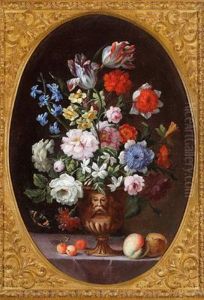Anna Stanchi Paintings
Anna Stanchi was an Italian painter born in 1635, belonging to the Baroque period, a time characterized by dramatic expression, rich colors, and intense light and shadow contrasts. She was part of the Stanchi family, a notable dynasty of painters from Florence, which included her father, Francesco Stanchi, and her brothers, Giovanni and Niccolò, who were also accomplished artists. Despite the prominence of her family in the art world, details about her life are relatively scarce, likely due to the historical undervaluation and underdocumentation of female artists.
Anna Stanchi's works are primarily known for their intricate still lifes, a genre that gained significant popularity in the 17th century. Her paintings often depicted flowers and fruits with meticulous attention to detail, texture, and color, showcasing a deep understanding of botanical subjects and a keen eye for composition. These pieces not only highlight her technical skill but also reflect the era's fascination with nature, exploration, and the scientific study of flora and fauna.
Unfortunately, like many female artists of her time, Anna Stanchi's contributions to the art world have been somewhat overshadowed by her male contemporaries. Historical records of her work are limited, and her death date remains unknown. However, recent scholarship has begun to shed more light on the achievements of women in the arts, including Stanchi. Her surviving works, though few, are critical to understanding the role of women artists in the Baroque period and the broader history of still life painting.
Through the lens of today's increased interest in the contributions of women to art history, Anna Stanchi's work is being reassessed and gaining recognition. Her paintings, characterized by their vibrant colors and dynamic compositions, offer a glimpse into the life of a talented artist who navigated the challenges of a male-dominated field with her remarkable artistry. As more of her works are studied and appreciated, Anna Stanchi's place in the history of Italian Baroque art continues to be reevaluated and celebrated.

